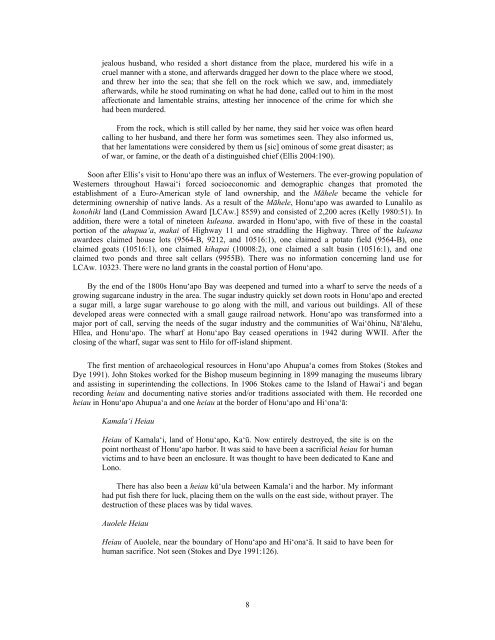Honu'apo Park Resource Management Plan
Honu'apo Park Resource Management Plan
Honu'apo Park Resource Management Plan
Create successful ePaper yourself
Turn your PDF publications into a flip-book with our unique Google optimized e-Paper software.
jealous husband, who resided a short distance from the place, murdered his wife in a<br />
cruel manner with a stone, and afterwards dragged her down to the place where we stood,<br />
and threw her into the sea; that she fell on the rock which we saw, and, immediately<br />
afterwards, while he stood ruminating on what he had done, called out to him in the most<br />
affectionate and lamentable strains, attesting her innocence of the crime for which she<br />
had been murdered.<br />
From the rock, which is still called by her name, they said her voice was often heard<br />
calling to her husband, and there her form was sometimes seen. They also informed us,<br />
that her lamentations were considered by them us [sic] ominous of some great disaster; as<br />
of war, or famine, or the death of a distinguished chief (Ellis 2004:190).<br />
Soon after Ellis’s visit to Honu‘apo there was an influx of Westerners. The ever-growing population of<br />
Westerners throughout Hawai‘i forced socioeconomic and demographic changes that promoted the<br />
establishment of a Euro-American style of land ownership, and the Māhele became the vehicle for<br />
determining ownership of native lands. As a result of the Māhele, Honu‘apo was awarded to Lunalilo as<br />
konohiki land (Land Commission Award [LCAw.] 8559) and consisted of 2,200 acres (Kelly 1980:51). In<br />
addition, there were a total of nineteen kuleana. awarded in Honu‘apo, with five of these in the coastal<br />
portion of the ahupua‘a, makai of Highway 11 and one straddling the Highway. Three of the kuleana<br />
awardees claimed house lots (9564-B, 9212, and 10516:1), one claimed a potato field (9564-B), one<br />
claimed goats (10516:1), one claimed kihapai (10008:2), one claimed a salt basin (10516:1), and one<br />
claimed two ponds and three salt cellars (9955B). There was no information concerning land use for<br />
LCAw. 10323. There were no land grants in the coastal portion of Honu‘apo.<br />
By the end of the 1800s Honu‘apo Bay was deepened and turned into a wharf to serve the needs of a<br />
growing sugarcane industry in the area. The sugar industry quickly set down roots in Honu‘apo and erected<br />
a sugar mill, a large sugar warehouse to go along with the mill, and various out buildings. All of these<br />
developed areas were connected with a small gauge railroad network. Honu‘apo was transformed into a<br />
major port of call, serving the needs of the sugar industry and the communities of Wai‘ōhinu, Nā‘ālehu,<br />
Hīlea, and Honu‘apo. The wharf at Honu‘apo Bay ceased operations in 1942 during WWII. After the<br />
closing of the wharf, sugar was sent to Hilo for off-island shipment.<br />
The first mention of archaeological resources in Honu‘apo Ahupua‘a comes from Stokes (Stokes and<br />
Dye 1991). John Stokes worked for the Bishop museum beginning in 1899 managing the museums library<br />
and assisting in superintending the collections. In 1906 Stokes came to the Island of Hawai‘i and began<br />
recording heiau and documenting native stories and/or traditions associated with them. He recorded one<br />
heiau in Honu‘apo Ahupua‘a and one heiau at the border of Honu‘apo and Hi‘ona‘ā:<br />
Kamala‘i Heiau<br />
Heiau of Kamala‘i, land of Honu‘apo, Ka‘ū. Now entirely destroyed, the site is on the<br />
point northeast of Honu‘apo harbor. It was said to have been a sacrificial heiau for human<br />
victims and to have been an enclosure. It was thought to have been dedicated to Kane and<br />
Lono.<br />
There has also been a heiau kū‘ula between Kamala‘i and the harbor. My informant<br />
had put fish there for luck, placing them on the walls on the east side, without prayer. The<br />
destruction of these places was by tidal waves.<br />
Auolele Heiau<br />
Heiau of Auolele, near the boundary of Honu‘apo and Hi‘ona‘ā. It said to have been for<br />
human sacrifice. Not seen (Stokes and Dye 1991:126).<br />
8


